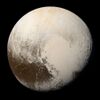Astronomy:2014 JM80
From HandWiki
| Discovery [1] | |
|---|---|
| Discovered by | Pan-STARRS 1 |
| Discovery site | Haleakala Obs. (first observed only) |
| Discovery date | 7 May 2014 |
| Designations | |
| 2014 JM80 | |
| Minor planet category | TNO [2] · SDO [3][4] distant [1] |
| Orbital characteristics [2] | |
| Epoch 27 April 2019 (JD 2458600.5) | |
| Uncertainty parameter 4 | |
| Observation arc | 2.93 yr (1,070 d) |
| |{{{apsis}}}|helion}} | 80.184 AU |
| |{{{apsis}}}|helion}} | 45.965 AU |
| 63.074 AU | |
| Eccentricity | 0.2713 |
| Orbital period | 500.94 yr (182,969 d) |
| Mean anomaly | 343.18° |
| Mean motion | 0° 0m 7.2s / day |
| Inclination | 20.479° |
| Longitude of ascending node | 182.43° |
| 96.342° | |
| Physical characteristics | |
| Mean diameter | 329 km[5] 352 km[3] |
| Absolute magnitude (H) | 5.5[1][2] |
2014 JM80 is a trans-Neptunian object from the scattered disc in the outermost Solar System, approximately 340 kilometers (210 miles) in diameter. It was first observed on 7 May 2014 by the Pan-STARRS-1 survey at the Haleakala Observatory, Hawaii, in the United States.[1] According to American astronomer Michael Brown, it is "possibly" a dwarf planet.[3][5]
Orbit and classification
2014 JM80 orbits the Sun at a distance of 46.0–80.2 AU once every 500 years and 11 months (182,969 days; semi-major axis of 63.07 AU). Its orbit has an eccentricity of 0.27 and an inclination of 20° with respect to the ecliptic.[2]
References
- ↑ 1.0 1.1 1.2 1.3 "2014 JM80". Minor Planet Center. https://www.minorplanetcenter.net/db_search/show_object?object_id=2014+JM80. Retrieved 9 October 2018.
- ↑ 2.0 2.1 2.2 2.3 "JPL Small-Body Database Browser: (2014 JM80)". Jet Propulsion Laboratory. https://ssd.jpl.nasa.gov/sbdb.cgi?sstr=3755645. Retrieved 9 October 2018.
- ↑ 3.0 3.1 3.2 Johnston, Wm. Robert (30 December 2017). "List of Known Trans-Neptunian Objects". Johnston's Archive. http://www.johnstonsarchive.net/astro/tnoslist.html. Retrieved 9 February 2018.
- ↑ "List Of Centaurs and Scattered-Disk Objects". Minor Planet Center. https://www.minorplanetcenter.net/iau/lists/t_centaurs.html. Retrieved 9 February 2018.
- ↑ 5.0 5.1 Brown, Michael E.. "How many dwarf planets are there in the outer solar system?". California Institute of Technology. http://web.gps.caltech.edu/~mbrown/dps.html. Retrieved 9 February 2018.
External links
- 2014 JM80 at AstDyS-2, Asteroids—Dynamic Site
- 2014 JM80 at the JPL Small-Body Database



